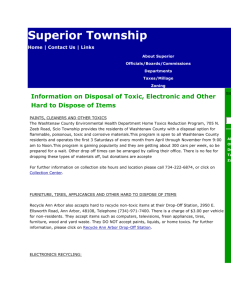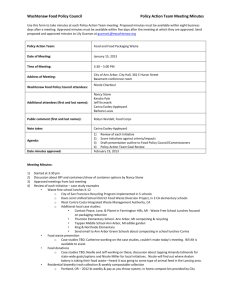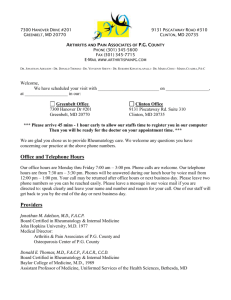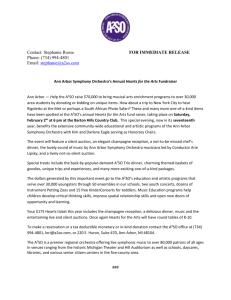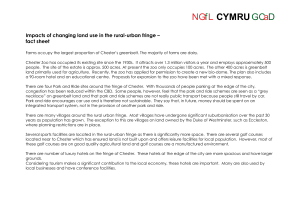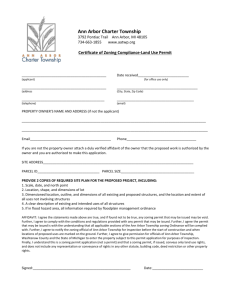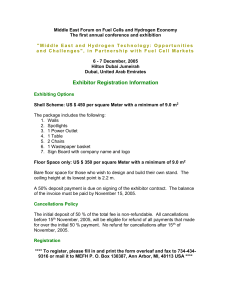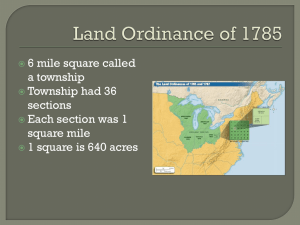Strategic Plan Blocks - The City of Ann Arbor
advertisement
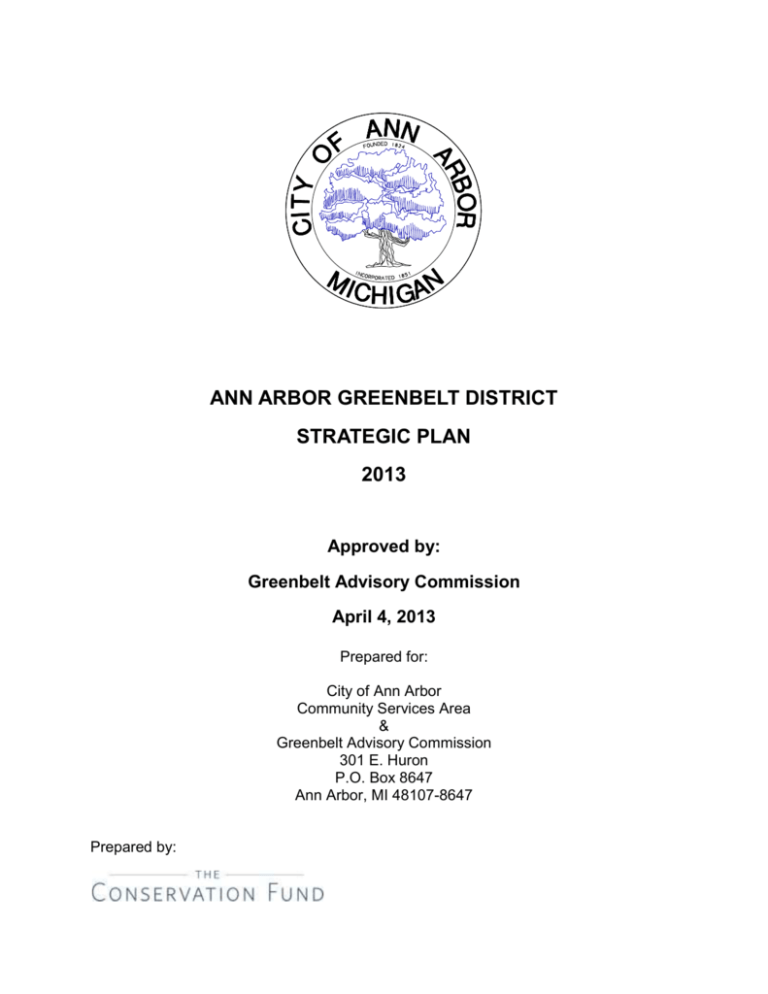
ANN ARBOR GREENBELT DISTRICT STRATEGIC PLAN 2013 Approved by: Greenbelt Advisory Commission April 4, 2013 Prepared for: City of Ann Arbor Community Services Area & Greenbelt Advisory Commission 301 E. Huron P.O. Box 8647 Ann Arbor, MI 48107-8647 Prepared by: TABLE OF CONTENTS 1. Introduction .............................................................................................................. 3 2. Agriculture in Southeast Michigan and Washtenaw County .......................................... 4 3. Farmland Preservation ............................................................................................... 5 Strategic Plan Blocks ................................................................................................................... 5 Local Food and New Farmers ...................................................................................................... 8 4. Open Space Protection ............................................................................................... 9 Huron River ................................................................................................................................. 9 Viewsheds ................................................................................................................................. 11 Recreation and Accessibility...................................................................................................... 11 5. Preserve Washtenaw ............................................................................................... 13 6. Leveraging Funds ..................................................................................................... 13 Landowners .................................................................................................................... 14 Landowner Matching Funds ..................................................................................................... 15 7. Monitoring and Enforcement .................................................................................... 15 Open Space Fee Simple Purchases: ........................................................................................... 15 8. Education and Outreach ........................................................................................... 16 9. Yearly Strategic Plan Review ..................................................................................... 16 Approved April 4, 2013 by the Greenbelt Advisory Commission 2 1. Introduction In November 2003, residents of Ann Arbor approved a ballot proposal commonly known as the Greenbelt Program. The purpose of this initiative is to provide funds to preserve and protect open space, farmland, natural habitats, and the City’s source waters inside and outside the city limits. In May 2004, the Ann Arbor City Council adopted Chapter 42, “Open Space and Parkland Preservation,” of the Ann Arbor City Code, providing a framework for the purchase of conservation easements and fee properties within the Greenbelt District. The Greenbelt Advisory Commission developed scoring criteria to rank the applications received. The scoring criteria rank the applications based on the following parameters: Characteristics of the land: type of agricultural land or mature habitats, parcel size, road frontage, wetlands and / or floodplain, groundwater recharge and natural features, proximity to Huron River or tributary, percent of land nominated. Context: proximity to city limits and other protected land, adjacent zoning and land use, scenic and / or historical value, Township Master Plan designation, and Township PDR Ordinance or Natural Features Ordinance. Acquisition considerations: sources of matching funds, landowner contribution, recreation potential. The first strategic plan for the Greenbelt Program was adopted by the Greenbelt Advisory Commission in 2006. This first plan called for an emphasis on preserving large blocks of farmland within 5 designated focus areas of the Greenbelt District (see Appendix A for map), forming partnerships through Preserve Washtenaw members and other funding sources, such as Federal Farm and Ranchland Protection Program, and preserving land along the Huron River. In 2009, the Greenbelt Advisory Commission reaffirmed these strategic priorities as well as called for the protection of farmland to specifically foster local food production within the area. Since the first acquisition in 2005, the Greenbelt has purchased the development rights or contributed funds toward the preservation on 34 properties totaling over 3,700 acres. This includes the Greenbelt’s contribution toward the protection of 4 properties totaling 379 acres, in collaboration with the County, which are now County Preserves and have public access. The Ann Arbor area is fortunate to not only have a number of locally funded land preservation programs, but a diversity of other organizations and programs that help support land preservation efforts and to support the local agriculture industry. This updated Strategic Plan has prioritized 4 primary areas to focus over the next 3-5 years, each of which will be discussed in more detail later in the document: 1.) Building vibrant blocks of farmland within priority areas; 2.) Open space protection, specifically protection of the Huron River Watershed and viewsheds 3.) Leveraging funds and creating partnerships Approved April 4, 2013 by the Greenbelt Advisory Commission 3 4.) Conducting Outreach and Education to Ann Arbor residents and other Greenbelt constituents. 2. Agriculture in Southeast Michigan and Washtenaw County While the Greenbelt program includes only a portion of the regional agriculture land base, it is important to review the larger agriculture region to understand the importance of agriculture in the region and the role the Greenbelt Program plays in preserving agriculture in the Ann Arbor area. Southeast Michigan’s 10 county region is number 1 in Michigan for the number of retail food and food service establishments and number 2 in the state for the value of direct-toconsumer sales (totaling $14,407,000)1. Furthermore, based on the 2007 Agriculture Census data, the market value of all agriculture products sold in Washtenaw County account for over $73 million, a 34% increase from the 2002 census. Although Washtenaw County has seen a steady increase in value of agriculture products, the County has seen a steady decline in agriculture land since 1940, when 458,240 acres were in active production in the County. By 1978, the County had experienced almost 50% decrease in acres devoted agriculture – a decline to 235,477 acres. Between the 2002 and 2007 census data, the County saw a 5% decrease in the land in farmland – from 175,259 acres to 166,881 acres. Below are 3 graphs with data from the 2007 Agriculture Census outlining the farm sizes and crops grown in Washtenaw County. Note: At the time of this report, the 2007 Agriculture Census is the most current census data available. Washtenaw County Farms by Size 599 372 135 115 52 1 to 9 acres 1 10 to 49 acres 50 to 179 acres 180 to 499 acres 500 to 999 acres 27 1,000 acres or more Michigan Food and Agriculture Systems Profiles, Revised October 2009. Approved April 4, 2013 by the Greenbelt Advisory Commission 4 Table 1: Source of data is 2007 USDA Agriculture Census Table 2: Source of data is 2007 USDA Agriculture Census WASHTENAW Livestock Dairy 19 Goats Sheep Chickens broiler operations Layers 0 Operations 3 Operations Hogs 26 500 or more 6 200 - 499 0 20 - 199 7 1 thru 19 500 or more Cattle 9 1000 or more 200-499 30 25-199 0 1 thru 24 6 100-199 20 - 99 12 200-999 89 62 1 THRU 19 149 143 114 Table 3: Source of data is 2007 USDA Agriculture Census 3. Farmland Preservation Strategic Plan Blocks As noted above, agricultural land traditionally has seen a steady decline over the decades and has been threatened land by development within the Greenbelt District. This has been due not only to the sale of individual parcels for development, but also by a need for large blocks of land to sustain agricultural production. Although there is currently little development pressure in the area, due to the downturn in the real estate market and overall economic conditions over the last several years, over the next 3-5 years, the Greenbelt Program will continue to focus on forming 1000-acre blocks -or larger- of protected farms of varying sizes in order to create a diverse farmland base to insure the long term viability of agriculture for future Approved April 4, 2013 by the Greenbelt Advisory Commission 5 producers. Thus, this strategic plan recommends a major emphasis on purchasing development rights from farmers. Map 1: Greenbelt Strategic Plan Blocks Approved April 4, 2013 by the Greenbelt Advisory Commission 6 The above map outlines the 5 focus areas for farmland preservation, which are further described below: 1. Lodi Township Block: The Greenbelt Program completed its first deal in Lodi Township in 2009, with the protection of the Frederick Farm, now owned by Mike and Hope Vestergaard. Since then, the Greenbelt has protected the Lindemann Farm in Lodi Township. These deals appear to have sparked an increased interest from landowners in Lodi Township, with the program receiving 4 new applications over the last year. The township has large viable blocks of farmland remaining and did not see the over abundance of subdivision development during the development boom. Therefore, this is a prime area for expansion of Greenbelt efforts over the next 3-5 years. 2. Northern Scio, Webster Township, and east Northfield Twp Block: This area has been one of the most active areas for farmland preservation within the Greenbelt District, particularly in Webster Township. This is due, in large part, to the passage of millages in both Webster and Scio Townships. This area, although located in between Dexter and Ann Arbor that saw tremendous development in the development boom, still contains viable blocks of farmland. This area also has a high number of areas critical for Huron River Watershed protection based on the Huron Watershed Council’s BioReserve Project. Due to the local partnerships and Townships’ dedication to land preservation, this is an area for further expansion of Greenbelt efforts over the next 3-5 years. 3. Northfield and Ann Arbor Townships Block: Since 2009, when the Strategic Plan was last updated, this area has seen tremendous successes in relationship to not only land preservation, but other supporting systems for the local agriculture economy. The Greenbelt and Ann Arbor Township have protected over 1,400 acres of land, primarily along the Whitmore Lake and Pontiac Trail corridors. In addition to the land preservation efforts, Ann Arbor Township has leased farmland owned by the Township to the Food System Economic Partnership to develop a farm incubator center – Tilian Farm Develop Center to support new and beginning farmers. In addition, a local farmer has purchased a 16-acre property adjacent to over 600 acres of protected land to start the Washtenaw Food Hub, which will provide central aggregation and distribution center for locally grown food, direct to local consumers. With the addition of these local agricultural support services, and the Township supporting land preservation this is an area for continued expansion of Greenbelt efforts over the next 3-5 years in collaboration with local partners. 4. Salem and Superior Townships Block: To date, the Greenbelt efforts have focused primarily along the Prospect Road Corridor in Superior Township in collaboration with the Southeast Michigan Land Conservancy and Washtenaw County Parks and Recreation. In addition, the Greenbelt has protected a couple of farms along the Five Mile Corridor. Given Southeast Michigan Land Conservancy’s focus in Superior Township, and Salem’s Township’s recent allocation of funds towards land preservation, it is anticipated that there will be many opportunities to expand the Greenbelt over the next 3-5 years. 5. Pittsfield Township: The Greenbelt has protected one property totaling 89 acres in Pittsfield Township. While most of the Township’s area designated for preservation lies Approved April 4, 2013 by the Greenbelt Advisory Commission 7 outside of the Greenbelt District, this is an area for the Greenbelt to help sustain current agriculture production and protection of existing natural resources. Strategic Plan Block Acres Completed Acres Approved Total Acres Web. / Scio 1364 0 1364 Northfield / Ann Arbor 1443 0 1443 Salem / Superior 819 0 819 Pittsfield 89 0 89 Lodi 341 0 341 Not within Strategic Blocks 170 0 170 *Note: These figures are for the Greenbelt related purchases only and do not take into consideration other protected property, where the Greenbelt was not involved. While it is difficult to assign a percentage of focus of the Greenbelt acquisitions, as the program is dependent upon applications, the Greenbelt Program will strive to have approximately 90 percent of the funds focused on preserving blocks of land. Local Food and New Farmers In 2009 the Greenbelt Advisory Commission identified direct to consumer agriculture products, agritourism, and other agricultural specialty products sold directly to Ann Arbor markets as an emerging issue. Several local markets, restaurants, private ventures (Washtenaw Food Hub), and non-profits (Slow Food of Huron Valley, Food System Economic Partnership, Fair Food Network) have all focused on the environmental, health, economic and community benefits of buying and selling local foods and other agricultural specialty products. In addition, we feel that a visible connection to our Greenbelt through the foods and agricultural products that Ann Arbor residents buy provides a tangible reminder of our preservation efforts. Local foods and other crops can find their way in to our Ann Arbor economy in a number of diverse ways: the Ann Arbor Farmers Market, local food stores, direct restaurant purchases from farms, U-pick farms, and even at larger chain groceries through regional food distributors. Approved April 4, 2013 by the Greenbelt Advisory Commission 8 Recognizing that the Greenbelt's mission is solely the protection of land, the Greenbelt program will make a priority to protect those farms that are producing foods for Ann Arbor markets and consumers. Even without this priority in our previous strategic plans, the Greenbelt program has actually preserved several farms that provide local food or other crops to the Ann Arbor area. In addition, the Greenbelt’s land preservation efforts play a significant role in helping new or beginning farmers increase access to land, which is often a barrier for new farmers to establish their farm business close to Ann Arbor. We have seen this through a number of recent purchases of preserved farmland by first time buyers. First, the former Hilton farm in Pittsfield Township was purchased in 2009 by Duane Mason, a commodity crop farmer, who had previously only leased land nearby. Secondly, the Frederick Farm was purchased by the Vestergaard family in 2009 to convert the farm to a grass fed beef operation. Most recently, in 2012, the owners of Green Things Farm purchased the former Newton farm in Ann Arbor Township. Green Things Farm started at the nearby Tilian Farm Development Incubator. 4. Open Space Protection Huron River The protection of the Huron River continues to be a high priority for the Greenbelt Program. The Huron River is an important recreational and natural resource in the Ann Arbor area. In addition, the Huron River provides over 90% of the City’s drinking water supply. Over the last decade, the City has focused on protection of the land along the Huron River within the City limits. The Huron River is also part of a larger effort with Washtenaw County Parks and Recreation to establish a Border-to-Border trail through the County. Applications received either along the Huron River or which contain tributaries of the Huron River will be a priority for the Greenbelt, recognizing the significance of the Huron River to the Ann Arbor residents as their source of drinking water. Approved April 4, 2013 by the Greenbelt Advisory Commission 9 Map 2: Greenbelt Boundary and Huron River Watershed Approved April 4, 2013 by the Greenbelt Advisory Commission 10 Viewsheds The Greenbelt scoring criteria awards points to applications that provide scenic views, and visibility from major corridors frequently traveled by Ann Arbor residents. Examples of these major corridors are along the highways that surround the city, which are often an entryway into the City, or routes that are frequented by bikers. The scenic value of each of the applications will continue to be a part of the scoring criteria. Furthermore, the abovementioned strategic blocks encompass major corridors, so an added benefit of forming large blocks of protected land will be preserving critical viewsheds within the Greenbelt District. Recreation and Accessibility While the Greenbelt acquisitions have focused on the Purchase of Development Rights on farmland, which remains private ownership, the Greenbelt has partnered with Washtenaw County Parks and Recreation Commission on a number of acquisitions that provide passive recreation opportunities. In these instances, Washtenaw County Parks and Recreation owns and manages the land and the Greenbelt only contributes funds towards the acquisition. The Greenbelt will continue to seek partnership opportunities with Washtenaw County Parks and Recreation to provide additional recreation opportunities for Ann Arbor residents. In addition, the Greenbelt will prioritize applications with additional recreation opportunities or along major bike path corridors identified by the County. Approved April 4, 2013 by the Greenbelt Advisory Commission 11 Map 3: Greenbelt District and Bike Paths Approved April 4, 2013 by the Greenbelt Advisory Commission 12 5. Preserve Washtenaw The Greenbelt Advisory Commission acknowledges that townships within the Greenbelt that have passed millages or dedicated funds to land preservation will play a critical role in maximizing the Greenbelt impact. The Greenbelt Advisory Commission recognizes that these partnerships are also key to providing management for lands outside the City limits and to continuing the goal of developing a regional park, open space and farmland system throughout Washtenaw County. The City of Ann Arbor’s Greenbelt program is a charter member of “Preserve Washtenaw,” a consortium of Washtenaw County’s programs for land preservation. The Preserve Washtenaw includes all private (land conservancies) and public agencies actively protecting land in the county, through purchase (or donation) of conservation easements, or through the outright purchase of land. Active participation in Preserve Washtenaw meetings will be a key vehicle for identification of partnership opportunities to implement the objectives of the Greenbelt. The purpose of Preserve Washtenaw is: 1) To serve as a coordinating body for ongoing public and private land protection efforts, ensuring the highest possible level of cooperation and communication, and least possible amount of duplication and overlap. 2) To provide a virtual single point of entry for landowners interested in land protection and/or stewardship. 3) Preserve Washtenaw is advisory in nature. Its goal is to serve as a forum for establishing common priorities where feasible, leveraging available public and private resources, facilitating communications between members, and providing a clearer path of entry to citizens seeking information on resources. 4) From time-to-time, and as requested, Preserve Washtenaw may also provide technical advice to elected officials on public policy issues relating to land use, land protection and land stewardship. 6. Leveraging Funds The Greenbelt Program will make every effort to leverage funding within the strategic priorities identified above. Leveraging fund availability will be part of the scoring criteria. In the past, this leveraging has been done by selection of applications that meet State and Federal grant criteria, as well as partnering with township and the county funded programs. The State and Federal grant funds have provided a great deal of leverage over the past few years. However, partnering with these entities adds extra time and requirements to the process. Given the decrease in land values over the past few years, the Greenbelt Advisory Commission feels that the benefit of State and Federal assistance may not always outweigh the costs of doing Approved April 4, 2013 by the Greenbelt Advisory Commission 13 business with these agencies. We still place a priority on leveraging funds, but will consider applications that do not meet the State and Federal grant criteria. Sources of potential matching funds detailed below: Local sources: o Washtenaw County Natural Area Technical Advisory Commission (NATAC) and o Washtenaw County Agriculture Land Preservation Advisory Commission (ALPAC) o Ann Arbor Township Millage o Scio Township Millage o Webster Township Millage o Salem Township dedicated funds Federal and State Programs: o Federal Farm and Ranch Lands Protection Program o Michigan Agricultural Preservation Fund (via Township partner) Sources of Potential Matching Funds Millage Expiration Source of funds Dates Webster Township 2014 Scio Township 2014 Ann Arbor Township 2023 Salem Township Est. Annual allocation Lodi Township Per Deal Washtenaw County (NATAC) 2022 Washtenaw County (ALPAC) USDA Farm and Ranchland Protection Program 2022 Annual Federal allocation Est. Amount Levied Annually $100,000 $550,000 $330,000 $200,000 $1,000 Amount Leveraged to date $695,095 $417,750 $3,326,609 $62,100 $3,000 $2,400,000 $3,522,490 $800,000 $0 $7,255,707 $2,000,000 (statewide) $15,282,751 Total $6,280,000 Note: Those partners that have not contributed matching funds to date are due to the fact that they are new programs or funding sources. The Greenbelt and those programs are currently seeking partnership opportunities. Landowners It is critical that the City of Ann Arbor provides landowners with opportunities to maximize the funding that that they receive from the transaction by providing installment sales and flexibility on closing for like-kind exchanges (1031). Many agricultural producers are using purchase of Approved April 4, 2013 by the Greenbelt Advisory Commission 14 development rights funding to acquire additional property through the like-kind exchange or 1031 provision of the Internal Revenue Code. Installment sales that are available will allow landowners to spread out the payments, reducing capital gains and allowing the interest to be treated as ordinary income rather than being subject to capital gains taxes. Landowner Matching Funds Each landowner will be asked to consider donating a portion of their purchase of developments rights or purchase price to the program. The benefits of the donation will be explained by staff through a discussion and examples of how benefits work for landowners. . There are currently tax benefits for landowners making a donation of a conservation easement, or partial donation of value. Depending on the value of the contribution, they may deduct up to 30% of their Adjusted Gross Income, and carry forward the deduction for 5 years. 7. Monitoring and Enforcement Most of the Strategic Plan up to this point has focused on pre-acquisition criteria and priorities of the Greenbelt Program. However, just as important, is establishing criteria for postacquisition activities. To that point, the City of Ann Arbor will set aside an endowment fund for each purchase of development rights easement that is acquired with Greenbelt funds. These endowment funds will be established from millage proceeds and will be used to cover the ongoing monitoring and enforcement costs that will be incurred by the City to ensure effective oversight of the easements and to adequately enforce the easement terms. In addition, each of the purchase of development rights easements will be monitored on an annual basis. City staff or contractor will contact the landowner prior to the monitoring visit and will meet with the landowner during the monitoring visit to discuss any potential changes or concerns with the property. Monitoring reports will be kept in the city files, shared with the landowners and any grant agencies, as necessary. Due to the fact that other agencies or organizations may be better suited to monitor the land outside of the City limits, the endowment fund will be used to pay contractors to conduct the necessary annual monitoring and ongoing management of the sites. However, ownership of the easement deed or title to the land (depending on type of sale) will remain with the City of Ann Arbor. Open Space Fee Simple Purchases: The majority of the natural area and open space acquisitions along the Huron River are likely to be in collaboration with Washtenaw County, who, it is anticipated, will take the lead on management of these properties. Approved April 4, 2013 by the Greenbelt Advisory Commission 15 8. Education and Outreach Over the last couple of years, the Greenbelt Advisory Commission has prioritized the implementation of an annual outreach plan. The outreach plan should be a two-pronged approach with the primary targets being 1.) Ann Arbor residents to communicate the impact and importance of the Greenbelt Program, and 2.) Landowners within the Greenbelt District to sustain interest from potential applicants. In 2010, the Greenbelt held its first ever Bus Tour, that proved to be a great success. The Greenbelt plans to make this an annual event as a way to connect Ann Arbor residents to accomplishments of the Greenbelt Program. Furthermore, the Greenbelt has actively participated in local events such as the HomeGrown Festival, Local Food Summit, the Mayor’s GreenFair, Heart of the Lakes Annual Summit, among others. In addition, recognizing that over the next 3-5 years, the Greenbelt will likely shift in program focus and will not be able to acquire as many properties or easements annually, it is important that the Commission maintain contact with landowners in the Greenbelt District who may be interested in protecting their land in the future. Therefore, the Greenbelt will prioritize establishing a Greenbelt Registry Program. A land registry program is a listing of the properties that contain “special” natural features or has remained in farmland open space that landowners have voluntarily agreed to protect. This is an oral non-binding agreement between the City of Ann Arbor and the landowner. The landowner can end at any time, and the agreement does not affect the deed. The landowners agree to monitor and protect specific features of the property and notify the City if the landowner is planning on selling the property or if major threats have occurred. The purpose of the land registry is to identify significant parcels of land and, through voluntary agreements with landowners, take the first step toward protection of the land’s natural resources. Furthermore, a land registry program recognizes landowners for protecting significant open space/natural features. Ultimately, these lands could be protected permanently through a conservation easement. The landowner, by voluntarily agreeing to register their land, agrees to the following: Protect the land to the best of their ability Notify the City of Ann Arbor Greenbelt Staff of any significant changes they are planning or any natural changes that have occurred. Notify the City of Ann Arbor Greenbelt Staff of any intent to sell the property. 9. Yearly Strategic Plan Review As the economic and real estate conditions are in flux, it is recommended that the strategic plan be reviewed on an annual basis and revised, as needed to meet the current market trends. In addition, goals will be established on an annual basis based on the criteria outlined in the strategic plan and will be included in the annual report. Approved April 4, 2013 by the Greenbelt Advisory Commission 16
